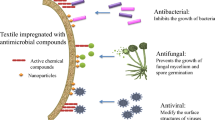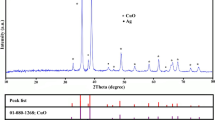Abstract
As a biopolymer-modified building block, a poly-dopamine layer can be utilized with a wide range of inorganic and organic materials for an adsorptive and microbial remediation. In this study, dopamine (DOPA) was used as a structural platform to bind silver onto the surface of kapok fibers, and a composite of surface-modified kapok fibers coated with DOPA along with silver were successfully manufactured. After a silver-coating process, a very strong antibacterial property was exhibited against Staphylococcus aureus with a high antibacterial efficiency, over 99 %, which could last for 48 h in peptone water. Enumeration determination was carried out in a spread plate method. For a comparative study, the antibacterial activity of raw kapok fibers and chemically enhanced kapok fibers with DOPA and silver was also evaluated. The results indicated that the chemically enhanced kapok fibers were very useful in controlling a microbial activity on a surface environment.







Similar content being viewed by others
References
Abdel-Mohsen, A. M., Hrdina, R., Burgert, L., Abdel-Rahman, R. M., Hasova, M., Smejkalova, D., Kolar, M., Pekar, M., & Aly, A. S. (2013). Antibacterial activity and cell viability of hyaluronan fiber with silver nanoparticles. Carbohydrate Polymers, 92, 1177–1187.
Abdullah, M. A., Rahmah A. U., Man Z. (2010). Physicochemical and sorption characteristics of Malaysian Ceiba pentandra (L.) Gaertn as a natural oil sorbent. J Hazardon Materials, 177, 683–691.
Arian, R. A., Khatri, Z., Memon, M. H., & Kim, I. S. (2013). Antibacterial property and characterization of cotton fabric treated with chitosan/AgCl-TiO(2) colloid. Carbohydrate Polymers, 96, 326–331.
Budama, L., Cakir, B. A., Topel, O., & Hoda, N. (2013). A new strategy for producing antibacterial textile surfaces using silver nanoparticles. Chemical Engineering Journal, 228, 489–495.
Chen, K. T., Ray, D., Peng, Y. H., & Hsu, Y. C. (2013). Preparation of Cu–Ag core–shell particles with their anti-oxidation and antibacterial properties. Current Applied Physics, 13, 1496–1501.
Dastjerdi, R., Montazer, M., & Shahsavan, S. (2009). A new method to stabilize nanoparticles on textile surfaces. Colloids and Surfaces A: Physicochemical and Engineering Aspects, 345, 202–210.
Ghafari-Nazari, A., Moztarzadeh, F., Rabiee, S. M., Rajabloo, T., Mozafari, M., & Tayebi, L. (2012). Antibacterial activity of silver photodeposited nepheline thin film coatings. Ceramics International, 38, 5445–5451.
Gulrajani, M. L., Gupta, D., Periyasamy, S., & Muthu, S. G. (2008). Preparation and application of silver nanoparticles on silk for imparting antimicrobial properties. Journal of Applied Polymer Science, 108, 614–623.
Guzman, M., Dille, J., & Stephane Godet, S. (2012). Synthesis and antibacterial activity of silver nanoparticles against gram-positive and gram-negative bacteria. Nanomedicine: Nanotechnology, Biology and Medicine, 8, 37–45.
Hsieh, J. H., Chiu, C. H., Li, C., Wu, W., & Chang, S. Y. (2013). Development of anti-wear and anti-bacteria TaN-(Ag, Cu) thin films—a review. Surface and Coatings Technology, 233, 159–168.
Ibrahim, N. A., Aly, A. A., & Gouda, M. (2008). Enhancing the antibacterial properties of cotton fabric. Journal of Industrial Textiles, 37, 203–212.
Ilic, V., Saponjic, Z., Vodnik, V., Molina, R., Dimitrijevic, S., Jovancic, P., Nedeljkovic, J., & Radetic, M. (2009). Antifungal efficiency of corona pretreated polyester and polyamide fabrics loaded with Ag nanoparticles. Journal of Materials Science, 44, 3983–3990.
Jeon, H. J., Yi, S. C., & Oh, S. G. (2003). Preparation and antibacterial effects of Ag–SiO2 thin films by sol–gel method. Biomaterials, 24, 4921–4928.
Keko, H., Maxima, E. F., Shigenori, K., Thi, B. T. L., & Kenji, L. (2000). Exellent oil absorbant kapok [Ceiba pentandra (L.) Gaertn.] fiber structure, chemical characteristics, and application. Journal of Wood Science, 46, 401–404.
Lee, H., Dellatore, S. M., Miller, W. M., & Messersmith, P. B. (2007). Mussel-inspired surface chemistry for multifunctional coatings. Science, 318, 426–430.
Lee, H., Lee, Y., Statz, A. R., Rho, J., Park, T. G., & Messersmith, P. B. (2008). Substrate-independent layer-by-layer assembly by using mussel-adhesive-inspired polymers. Advanced Materials, 20, 1619–1623.
Lee, S. M., Lee, B. S., Byun, T. G., & Song, K. C. (2010). Preparation and antibacterial activity of silver-doped organic–inorganic hybrid coatings on glass substrates. Colloids and Surfaces A: Physicochemical and Engineering Aspects, 355, 167–171.
Li, C., Wang, X., Chen, F., Zhang, C., Zhi, X., Wang, K., & Cui, D. (2013). The antifungal activity of graphene oxide–silver nanocomposites. Biomaterials, 34, 3882–3890.
Lim, T. T., & Huang, X. (2007). Evaluation of hydrophobicity/oleophilicity of kapok and its performance in oily water filtration: comparison of raw and solvent-treated fibers. Industrial Crops and Products, 26, 125–134.
Nithya, E., Radhai, R., Rajendran, R., Jayakumar, S., & Vaideki, K. (2012). Enhancement of the antimicrobial property of cotton fabric using plasma and enzyme pre-treatments. Carbohydrate Polymers, 88, 986–991.
Postma, A., Yan, Y., Wang, Y., Zelikin, A. N., Tjipto, E., & Caruso, F. (2009). Self-polymerization of dopamine as a versatile and robust technique to prepare polymer capsules. Chemistry of Materials, 21, 3042–3044.
Rehan, M., Hartwig, A., Ott, M., Gätjen, L., & Wilken, R. (2013). Enhancement of photocatalytic self-cleaning activity and antimicrobial properties of poly(ethylene terephthalate) fabrics. Surface and Coatings Technology, 219, 50–58.
Tarimala, S., Kothari, N., Abidi, N., Hequet, E., Fralick, J., & Dai, L. L. (2006). New approach to antibacterial treatment of cotton fabric with silver nanoparticle-doped silica using sol–gel process. Journal of Applied Polymer Science, 101, 2938–2943.
Tenover, F. C. (2006). Mechanisms of antimicrobial resistance in bacteria. The American Journal of Medicine, 119, S3–10; discussion S62–70.
Wang, W., Jiang, Y., Liao, Y., Tian, M., Zou, H., & Zhang, L. (2011). Fabrication of silver-coated silica microspheres through mussel-inspired surface functionalization. Journal of Colloid and Interface Science, 358, 567–574.
Wang, J., Zheng, Y., & Wang, A. (2012). Effect of kapok fiber treated with various solvents on oil absorbency. Industrial Crops and Products, 40, 178–184.
Wang, R., Shin, C. H., Park, S., Park, J. S., Kim, D. I., Cui, L. Z., & Ryu, M. H. (2014). Removal of lead (II) from aqueous stream by chemically-enhanced kapok fiber adsorption. Journal of Environmental Earth Sciences, 72, 5221–5227.
Xing, Y., Yang, X., & Dai, J. (2007). Antimicrobial finishing of cotton textile based on water glass by sol–gel method. Journal of Sol–gel Science and Technology, 43, 187–192.
Xu, H., Shi, X., Ma, H., Lv, Y., Zhang, L., & Mao, Z. (2011). The preparation and antibacterial effects of dopa-cotton/AgNPs. Applied Surface Science, 257, 6799–6803.
Yin, X. B., & Liu, D. Y. (2008). Polydopamine-based permanent coating capillary electrochromatography for auxin determination. Journal of Chromatography A, 1212, 130–136.
Zhang, R. X., Braeken, L., Luis, P., Wang, X. L., & Van der Bruggen, B. (2013). Novel binding procedure of TiO2 nanoparticles to thin film composite membranes via self-polymerized polydopamine. Journal of Membrane Science, 437, 179–188.
Acknowledgments
The authors would like to thank Dr. Tae-Sung Bae and his laboratory staff members at the Korean Basic Science Institute (KBSI) for the instrumental analysis.
Author information
Authors and Affiliations
Corresponding author
Rights and permissions
About this article
Cite this article
Wang, R., Shin, C.h., Park, S. et al. Enhanced Antibacterial Activity of Silver-Coated Kapok Fibers Through Dopamine Functionalization. Water Air Soil Pollut 226, 2241 (2015). https://doi.org/10.1007/s11270-014-2241-1
Received:
Accepted:
Published:
DOI: https://doi.org/10.1007/s11270-014-2241-1




